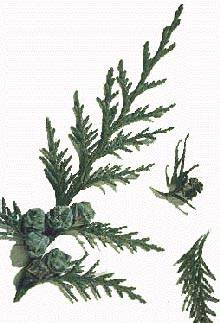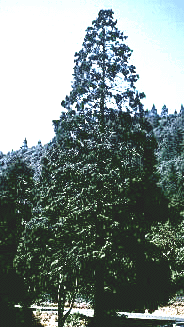Port Orford Cedar
provided
by Master Garden Products
Port-Orford-cedar is one of the white-cedars in a group of "false-cypresses," numbering three native species in the U.S. and four additional species in Japan and Taiwan.
The Port-Orford-cedar (Chamaecyparis lawsoniana) was first discovered in its small natural range along the California/Oregon coast in 1851. The total range was only about 200 miles long north and south and about 50 miles deep, shared by both states, about 70 percent in Oregon.
Port-Orford-cedar, also known as Port-Orford white-cedar, Oregon-cedar and Lawson cypress prefers a mild climate with plenty of rain (40-90 inches annually)! High humidity and misting from the Pacific Ocean are also factors in the healthy growth of this tree in its natural areas. The range has been extended by planting the original and its variations around much of the northern half of the world and in New Zealand.
These large attractive and very shade-tolerant trees grow to 125' to 180' in 500 years, with diameters of 3 1/2' � 6'. A record tree, 219' tall with a diameter of 12', standing in Siskiyou, Oregon may be 700 years old.

The leaves of this huge tree are only about 1/16" long, scale-like, bright green with pale undersides, spread along masses of short flat branchlets which have a fern-like appearance. The 3/8" diameter, coarse spherical cones cluster on upper branches in great masses, ripening in fall. Old growth, close-growing trees have relatively small, spire-like crowns of lateral, often pendulous branches of flat sprays only 6' to 8' long. A first branch may be 150' above the ground.

Bark on old trees is 6" to 8" thick, occasionally to 12", providing good fire protection for the massive buttressed trunks. The bark is deeply seamed into long, stringy, slender ridges, growing over a distinct, thin but very dense inner bark.
The wood of Port-Orford-cedar is clear with a straight, but somewhat uneven, medium grain. The wood is yellow-white in color, sometimes with tinges of red and has a bitter ginger taste. Sapwood is hardly distinguishable from heartwood. Of relatively light weight and good strength, this wood has a specific gravity of 0.40 and weighs about 27 pounds per cubic foot at 8% moisture content, about the same as eastern hemlock and a little heavier than eastern white pine.
The wood dries easily and quickly with no problems. It works well in every respect with power or hand-tools, polishes and takes paint, stain and all finishes extremely well. Its ease in staining makes it simple to imitate mahogany and other higher priced woods, adding to its popularity as a fine cabinet wood. Port-Orford-cedar is very stable in any application and when exposed to soil, water or weather is considered to be one of the most durable of woods.
The unique, strong ginger-like scent, due to a volatile oil, can be overpowering and continued exposure to this aroma is known to cause kidney problems. Dust masks and skin protection are recommended to avoid ingestion or contact with the oil or sawdust.
The wood of Port-Orford-cedar exhibits distinct growth rings with gradual transition from wide earlywood to a darker latewood. There are no resin canals or ray tracheids; longitudinal parenchyma is abundant. Uniseriate rays are very fine, plentiful and visible with a hand lens.
Port-Orford-cedar has been used for a wide variety of things from the Hawaiian Presidential Palace to Japanese Buddhist temples, California gold mine timbers and building construction. It was used for high quality boats � Sir Thomas Lipton used this wood for his Shamrock series of 100' racing sailboats, built as challengers for the Americas Cup just prior to World War 1.
This wood is in great demand in China and Japan for coffins and for temple construction because of its close relationship to Hinoki cypress (Chamaecyparis obtusa) which is though to have a spiritual nature.
This wood is also used for Venetian blinds, broom handles, boats, wet cell battery dividers, clothes chests, aircraft plywood, veneer and stringed instrument sound-boards. It is also an excellent wood for arrow shafts. Boughs of Port-Orford-cedar are popular in floral displays because of their pleasant scent and ease in coloring, and are widely distributed for this purpose.
Because of its uniform growth and dense foliage, Port-Orford-cedar is a very popular ornamental. Seed taken to England in 1854 immediately produced a variation, Erecta viridis. True seeds have been producing variations ever since � to the point where Port-Orford-cedar is considered the most variable conifer in the world with more than 250 named forms.
Port-Orford-cedar has become the most expensive timber harvested in Oregon today. Only a few mills are sawing it and prices run to $10.00/board foot for clear lumber.




